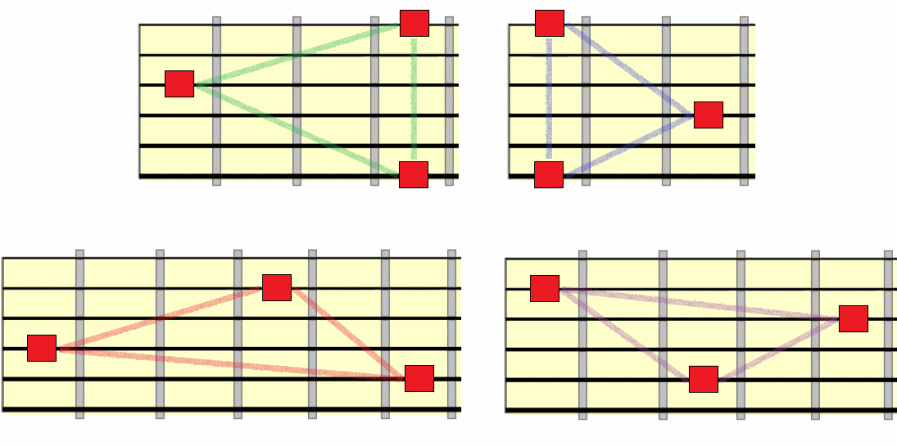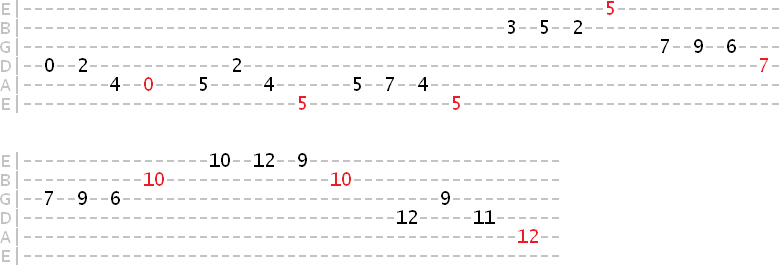Step 1: Root Patterns
This exercise challenges you to identify and play a given note sequentially on all strings - a skill that will ensure you can move between neck positions without hesitation.
While many guitarists successfully learn the note positions on each string, purely by parrot fashion, when you're playing in the moment it's often difficult to find your bearings. By seeing notes in the form of patterns, you'll create more of a relative, spatial memorization of these note positions and find it much easier to jump between them without having to think about it too much.
Let's use the note A
as our example. As you know, this note (like all notes) exists in
several positions across the neck...

The aim is to be able to pick any starting position and know where that same note exists in close proximity.
We can memorize some patterns to help with this. Note that these patterns are movable (i.e. relative to the note you're playing) and so work for any note...

All we're doing here is creating a spatial awareness of how the same note exists in close proximity.
For example, if you find a note on the 4th string, the same note lies three frets higher on the 2nd string.
If you find a note on the 5th string, the same note lies two frets higher on the 3rd string, or two frets lower on the 2nd string.
We can also see that the 1st and 6th strings create the same note at the same fret.
See if you can form similar string/fret relationships in your mind by using these note patterns.
To help, we can break these "clusters" down as follows....

Let's apply the same root patterns to the note D....

So no matter which fret/string you start on, once you've learned these patterns you'll know where the same note exists near by on other strings. As you learn chords and scales, these root patterns will help you to identify where a particular note exists throughout the pattern or shape, which will help you to find/keep your bearings.
This kind of spatial awareness will start to work in the background the more you internalise it.
Test yourself by picking random notes and playing between the note positions at regular timing intervals. The less hesitation, the better!
Make sure you also take this exercise beyond the 12th fret, playing the octave positions of the note.
To really test yourself (no pressure!), try this timed fretboard memorization game.
Step 2: Intervals
Here, we simply add an interval note to the root positions. Intervals are the building blocks of chords, arpeggios and scales, so knowing your intervals will help you connect these elements spatially and auditorily.
Minor 3rd
Let's take a minor 3rd (♭3) interval, again on the root of A, as our example...

Notice
how the interval note can also be visualized using the same patterns we
learned earlier, but obviously using a different note...

Again, try playing between related positions, playing both the root and interval and just the root or interval. While you're playing between the root and interval, really listen to how the interval sounds - how the movement sounds the same no matter which position you use, albeit higher or lower in pitch. Different positions for the same musical expression...
Test your ability to move smoothly between the positions (although it
doesn't have to be in a specific order)...

To further test yourself, choose other starting notes and intervals and
follow the same process. Some other intervals to try...
Major 3rd

As well as moving from root to interval (e.g. 1
- 3) you
should also explore how the relationship appears moving from interval
up to root
(or root down
to interval, whichever way you look at it, e.g. 3
- 1).

Perfect 5th

Tip:
you can also use these perfect 5th relationships to build power chords all
over the neck.








